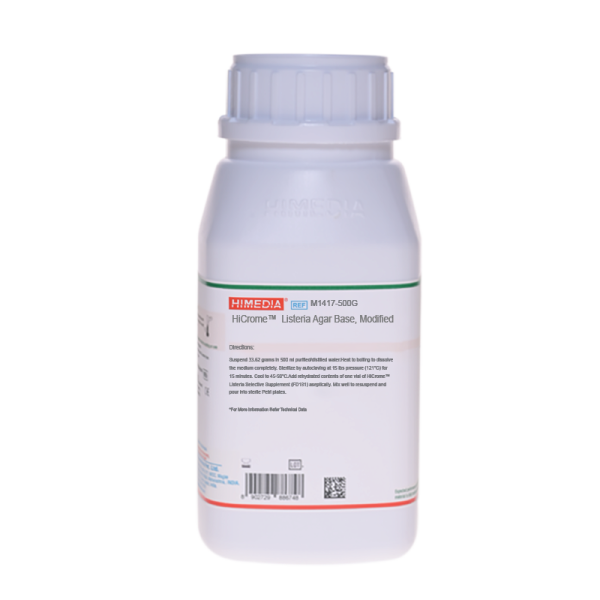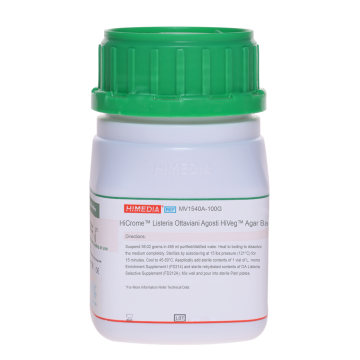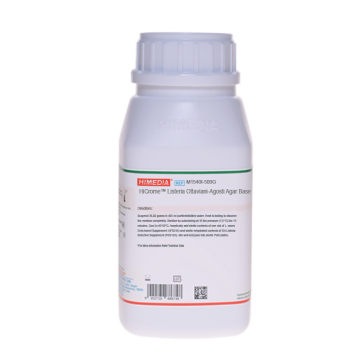 Your enquiry has been submitted
Your enquiry has been submitted
HiCrome™ Listeria Agar Base, Modified
Intended use
A selective and differential agar medium recommended for rapid and direct identification of Listeria species.
Composition**
| Ingredients | g/L |
|---|---|
| Peptone, special | 23.000 |
| Sodium chloride | 5.000 |
| Yeast extract | 1.000 |
| HM extract # | 5.000 |
| Lithium chloride | 5.000 |
| Rhamnose | 10.000 |
| Phenol red | 0.120 |
| Chromogenic mixture | 5.130 |
| Agar | 13.000 |
Final pH (at 25°C): 7.3±0.2
**Formula adjusted, standardized to suit performance parameters
Key: # - Equivalent to Meat extract
Directions
Suspend 33.62 gram in 500 ml purified/ distilled water. Heat to boiling to dissolve the medium completely. Sterilize by autoclaving at 15 lbs pressure (121°C) for 15 minutes. Cool to 45-50°C. Add rehydrated contents of 1 vial of CA Selective Supplement (FD181) aseptically. Mix well to resuspend and pour into sterile Petri plates.
Principle And Interpretation
HiCrome™ Listeria Agar Base, Modified is a modification of a medium first developed by Notermans et al. (1) and Mengaud et al.(2) for the detection of Listeria species from food stuffs. HiCrome™ Listeria Agar Base, Modified allows growth of Listeria species and gives a presumptive identification of Listeria monocytogenes within 24-48 hours after pre-enrichment. This medium is based on the specific chromogenic detection of ß -glucosidase activity and also rhamnose fermentation. Listeria species hydrolyse the purified chromogenic substrate in the medium giving blue coloured colonies. Since ß-glucosidase activity is specific for Listeria species, other organisms cannot utilize the chromogenic substrate and therefore give white colonies. Differentiation between Listeria species is based on the property of rhamnose fermentation. The colonies of L.monocytogenes and L.innocua appear blue with a yellow halo (rhamnose positive) while the colonies of L.ivanovii appear blue without a yellow halo (Rhamnose negative).
Peptone special, yeast extract and HM extract provide nitrogenous, carbonaceous substances, long chain amino acids, vitamin B complex and other essential growth nutrients. Rhamnose is the fermentable carbohydrate with phenol red as an indicator. Sodium chloride maintains the osmotic equilibrium. The added lithium chloride and CA Selective Supplement (FD181) inhibit growth of most gram-positive bacteria, gram-negative bacteria, yeasts and moulds.
Type of specimen
Clinical samples- blood; Food samples.
Specimen Collection and Handling
For clinical samples follow appropriate techniques for handling specimens as per established guidelines (3,4). For food samples, follow appropriate techniques for sample collection and processing as per guidelines (5). After use, contaminated materials must be sterilized by autoclaving before discarding.
Warning and Precautions
In Vitro diagnostic Use. For professional use only. Read the label before opening the container. Wear protective gloves/protective clothing/eye protection/ face protection. Follow good microbiological lab practices while handling specimens and culture. Standard precautions as per established guidelines should be followed while handling clinical specimens. Safety guidelines may be referred in individual safety data sheets.
Limitations
- Due to nutritional variations, some strains may show poor growth.
- Slight colour variation may be observed depending upon strains.
- Further biochemical tests must be carried out for confirmation.
Performance and Evaluation
Performance of the medium is expected when used as per the direction on the label within the expiry period when stored at recommended temperature.
Quality Control
Appearance Light yellow to pink homogeneous free flowing powder
Gelling Firm, comparable with 1.3% Agar gel.
Colour and Clarity of prepared medium Red coloured, clear to slightly opalescent gel forms in Petri plates
Reaction Reaction of 6.72% w/v aqueous solution at 25°C. pH: 7.3±0.2
pH 7.10-7.50
Cultural Response Cultural characteristics observed w/added CA Selective Supplement (FD181), after an incubation at 35-37°C for 24-48 hours.
| Organism | Inoculum (CFU) | Growth | Recovery | Colour of colony | Rhamnose fermentation |
|---|---|---|---|---|---|
| **Bacillus spizizenni ATCC 6633 (00003*) | >=104 | inhibited | 0%- | ||
| Candida albicans ATCC 10231 (00054*) | >=104 | inhibited | 0% | ||
| Escherichia coli ATCC 25922 (00013*) | >=104 | inhibited | 0% | ||
| Listeria innocua ATCC 33090 (00017*) | 50-100 | luxuriant | >=50% | bluish green | positive reaction, (yellow background) |
| Listeria ivanovii ATCC 19119 (00018*) | 50-100 | luxuriant | >=50% | bluish green | negative reaction |
| Listeria monocytogenes ATCC 19118 | 50-100 | luxuriant | >=50% | bluish green | positive reaction, (yellow halo) |
| Pseudomonas aeruginosa ATCC 27853 (00025*) | >=104 | inhibited | 0% |
Key: *Corresponding WDCM numbers and **Formerly known as Bacillus subtilis subsp. spizizenii
Storage and Shelf Life
Store between 15-25°C in a tightly closed container and the prepared medium at 2-8°C. Use before expiry date on the label. On opening, product should be properly stored dry, after tightly capping the bottle in order to prevent lump formation due to the hygroscopic nature of the product. Improper storage of the product may lead to lump formation. Store in dry ventilated area protected from extremes of temperature and sources of ignition Seal the container tightly after use. Product performance is best if used within stated expiry period.
Disposal
User must ensure safe disposal by autoclaving and/or incineration of used or unusable preparations of this product. Follow established laboratory procedures in disposing of infectious materials and material that comes into contact with clinical sample must be decontaminated and disposed of in accordance with current laboratory techniques (3,4).
Reference
- Notermans S.H. and Dufrenne J., (1991), Applied and Environmental Microbiology, 57(09): 2666-70.
- Mengaud J., Braun-Breton C. and Cossart P., (1991), Molecular Microbiology, 5(2): 367-372.
- Isenberg, H. Clinical Microbiology Procedures Handbook 2nd Edition.
- Murray P. R., Baron J. H., Pfaller M. A., Jorgensen J. H. and Yolken R. H., (Eds.), 2003, Manual of Clinical Microbiology, 8th Ed., American Society for Microbiology, Washington, D.C.
- Salfinger Y., and Tortorello M.L., 2015, Compendium of Methods for the Microbiological Examination of, Foods, 5th Ed., American Public Health Association, Washington, D.C.
| Product Name | HiCrome™ Listeria Agar Base, Modified |
|---|---|
| SKU | M1417 |
| Product Type | HiCrome™ |
| Physical Form | Powder |
| Origin | Animal |
| Packaging type | HDPE |
| References | 1. Isenberg, H. Clinical Microbiology Procedures Handbook 2nd Edition. |
| Customized Product Available | No |








